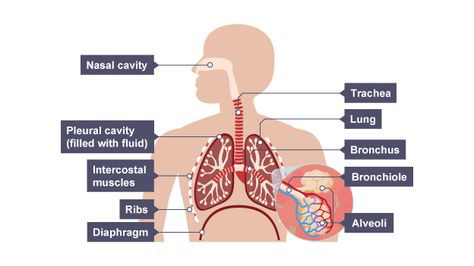Biology GCSE - Respiration, Breathing investigation and gas exchange in humans
[The Respiratory system, and ventilation
- You need to get oxygen into your bloodstream to supply your cells for respiration. You also need to get rid of carbon dioxide from your blood. This happens in your lungs when you breathe air in and out
- The lungs are in your thorax:
- The thorax is the top of your body. Its separated from the lower part of the body by the diaphragm
- The lungs are surrounded by plural membranes
- The lungs are protected by the ribcage, and the intercostal muscles run between the ribs.
- The air you breathe goes through the trachea - splits into two tubes - bronchi (each one: bronchus) - one to each lung.
- Bronchi - split into even smaller tubes called bronchioles
- Bronchioles finally end at small bags called alveoli - site of gas exchange.

- Breathing IN
- Intercostal Muscles and Diaphragm contract
- Thorax volume increases
- This decreases the pressure inside your lungs, drawing air in.
- Air goes in - muscles between ribs pull sternum up and out, diaphragm flattens
- Breathing OUT
- Intercostal muscles and Diaphragm relax
- Thorax volume decreases
- Air is forced out
- Ribcage and sternum drop in and down - diaphragm moves up
Investigating breathing
- ^^Experiment One^^
- Sit still for 5 minutes. Then, for one minute, count the number of breaths you take.
- Then do 4 minutes of exercise and as soon as you stop, count your breath for another minute
- Repeat the steps above and work out your mean results for resting and after exercise
- Your results should show that exercise increases breathing rate
- This is because your muscles respire more during exercise. They need to be supplied with more oxygen and have more carbon dioxide removed - so your breathing rate increases.
- During this experiment , you need to control all the variables that might affect your results: for example, the time spent exercising or the temperature of the room.
^^Gas Exchange: Humans^^
- Alveoli carry out gas exchange in the body
- The lungs contain millions and millions of little air sacs called alveoli, where gas exchange happens.
- The blood passing next to the alveoli has just returned to the lungs from the rest of the body, so it contains lots of carbon dioxide and little oxygen. Oxygen diffuses out of the alveolus and into the blood, but carbon dioxide diffuses out of the blood and into the alveolus to be breathed out.
- When the blood reaches body cells, oxygen is released from the red blood cells and diffuses into the body cells. At the same time, carbon dioxide diffuses out of the body cells into the blood. Its then carried back to the lungs
- The huge number of microscopic alveoli give the lungs an enormous surface area
- There’s a moist lining for gases to dissolve in
- The alveoli have very thin walls, so molecules can diffuse in and out - and they don’t have far to diffuse
- They have a great blood supply to maintain a high concentration gradient
- The walls are permeable
- Smoking can devastating affect your lungs and circulatory system:
- Smoking damages the walls inside the alveoli, reducing the Surface Area for gas exchange and leading to diseases like emphysema
- The tar in cigarettes damages the cilia, in your lungs and trachea. These hairs, along with mucas, catch dust and bacteria before they reach the lungs. The cilia also help keep the trachea clear by sweeping mucus back towards the mouth. When these cilia are damaged, chest infections are much more likely
- Tar also irritates the bronchi and bronchioles, encouraging mucus to be produced which can’t be cleared by the damaged cilia - this causes smokers cough and chronic bronchitis
- The carbon monoxide in cigarette smoke reduces the amount of oxygen the blood can carry. To make up for this, heart rate increases - leads to a blood pressure increases. High blood pressure damages artery walls - this makes blood clots more likely. This increases the risk of heart diseases.
- Tobacco smoke includes carcinogens - these can lead to cancer.